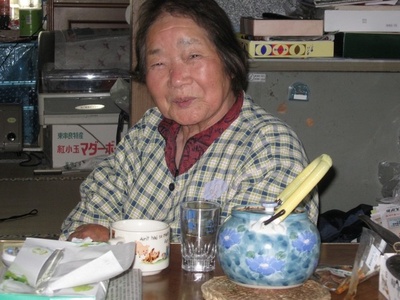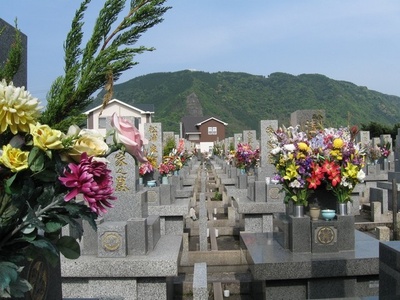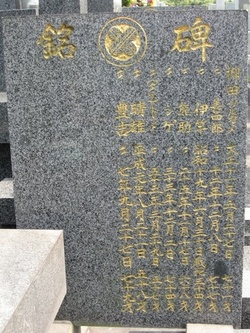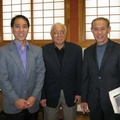>>> Read Part 1
We drive around to a remodeled housing track where once quaint one-story Japanese farmhouses have been replaced with two-story mansions. Did everyone strike money? Aunt Nobu-san still resides in a traditional farmhouse framed with the blue tile roof. She was eating a meal and told us that she was 80-years old. We felt a bit uncomfortable crowding around her entrance. I’m trying to soak in everything, looking for clues as to who this relative was. I spot a calendar hanging on the wall and lots of other knick-knacks, but the natural lighting made it difficult to view the inside of the room. She was very friendly and remembered the story of my grandmother’s size, which was very petite.
Grandma Sakoda was a premature baby so small that after her birth, her father could hold her in the palm of one hand. Her father used nature’s incubator, the only one in existence during that era and she was placed outside in the sun to grow like a cabbage (the original cabbage patch kid). Her parents decided to register her birth five-months after she was born; better a birth certificate than a death certificate, very pragmatic.
I relate to Nobu-san that the woman she talked about was my grandmother. I almost can’t believe that the legacy of my grandmother was still known almost a hundred years after she emigrated to the U.S. and by a niece-in-law at that.
Nobu-san tells us the location of the family cemetery so we can visit, “hakamairi.” We drive a little and fortuitously park almost in front of the Yanakita headstone. I had noticed a “kamon,” Japanese family crest that looked identical to the Yanakita family, 2-feathered arrows crossing downwards. My cohorts confirm that this tombstone does belong to my family. I’m elated. We say the customary prayer and also take a couple of photos and graphite rubbing, in case the photos can’t be read. There are a couple of nice surprises about the cemetery: the fresh flowers that adorn every grave. I was told that Kagoshima-ken buys per capita the most flowers in Japan.
My grandparents’ hometown of Kokubu was famous for flower growers, so much so that in the mid-1950s to early-1960s the U.S. government called for flower growers to come to Salinas, California and the call was answered by nursery people coming from Kokubu. (My grandparents’ generation helped the shin-Issei settle into the Salinas Valley, even though many of the newer immigrants were Buddhists and not Christians. The bonds between their fellow townspeople were much stronger than the differences in belief. To this day, the upkeep of the Yamato cemetery in Salinas is largely dependent upon the shin-Issei. They bring flowers regularly to the graves from their nurseries and also have taken the responsibility to upgrade and maintain the cemetery.)
Another surprise was written on the Yanakita headstone, the names of long past deceased relatives beginning with my great grandparents, Zenshiro and Tsurukane Yanakita. Masako-san, the interpretor, delivered another auspicious story about my great grandmother’s name, Tsurukane, which meant “crane and turtle.” These animals represented longevity in Japanese folklore. She continued and weaved into her story like a fortuneteller that my great grandmother was leaving me clues about how to find her grave, through my research of family names (incorrect and corrected) and my grandmother’s stories including the memory of her family crest. All of these and more lead me to find them. Now, I’m a bit skeptical about the spirits from beyond trying to contact me, but leaving clues for me to find was a nice way to think of one of my great grandmothers.
Before we departed the Yanakita grave, a lady who we spotted earlier stopped and chatted. She told us that she was the one who took care of the Yanakita grave. Unfortunately, I forgot her name, but she was the sister-in-law of Nobu-san. I am grateful to her and thank her profusely for her dedication.
With the light of day almost extinguished we head to the Uenohara Jomon no Mori, a museum on top of the plateau above the village of Shikine. According to archeologists this site contained the remnants of the first “Japanese” people to settle in Japan almost 10,000 years ago, otherwise known as the Jomon people. The museum was impressive displaying digital computer re-enactments of how archeologists believed the Jomon people lived. To think I could be related to the first “Japanese” people. I feel history coursing through my veins.
In dedication to my Yanakita family ancestors, I have written a haiku to honor their memory.
Obaachan waiting
ash falling, hunting for clues
ancestor’s graveyard
One day I plan to return to Kokubu and hopefully obtain the services of another person, Minami, Ichiji whom I was told had tracked down a Japanese soldier of WWII when a U.S. soldier wanted to return his medal. There still is a desire to find my mother’s father’s family.
Acknowledgements
Many people helped me locate my grandma Sakoda’s family: the Yanakita family. My auntie Haru Ishibashi, my cousin, Liz and her husband, Bill Goodson, in Osaka: my friend, Judy Hayashi - her husband, Masa and daughter, Eiko. The woman who worked at Kagoshimachuo’s tourist information center who connected me with Setsuko-san, an administrator at Kagoshima Junior College, who in-turned connected me with a volunteer interpretor, Masako Matsusaki and finally Tsumagari-san and his wife, Junko. Locating one’s family took many people and I definitely couldn’t have arrived there by myself.
REFERENCE
John Galsworthy, Over the River (London: William Heineman, 1933), p. 4.
© 2009 Troy Ishikawa








